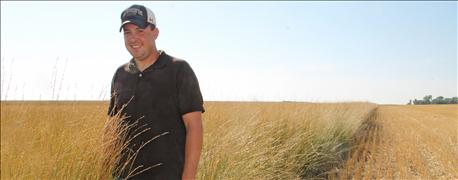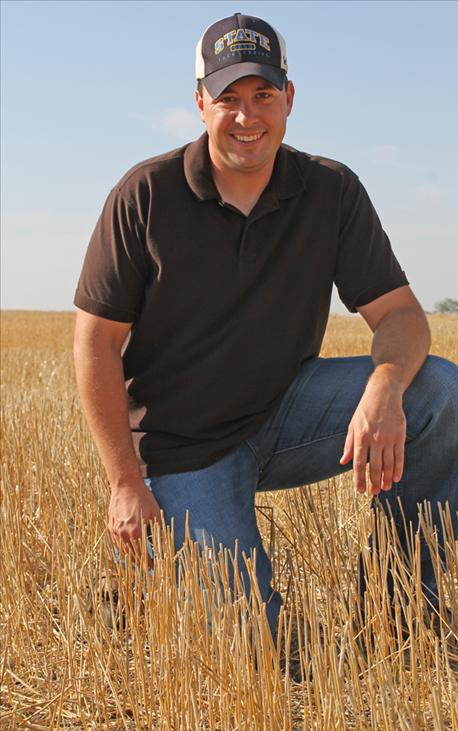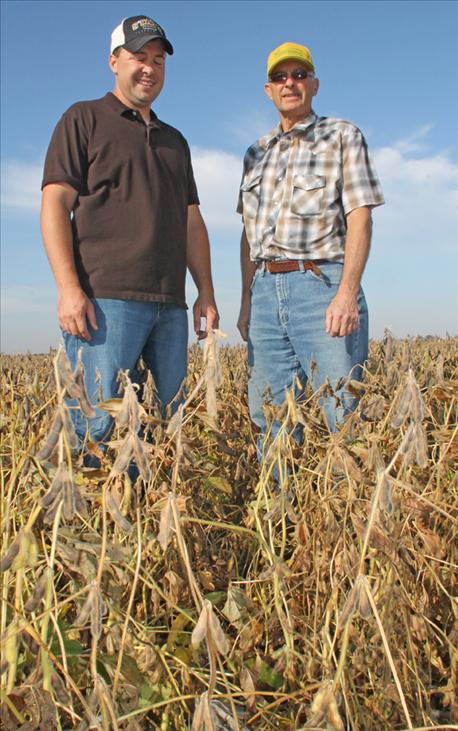July 29, 2016

Over the past four years, Brian Johnson has reclaimed some of the saline soils on his family’s farm. Johnson, Frankfort, S.D., has used the Conservation Reserve Program, small-grain crops, cover crops and drain tile to stop the spread and restore production of some of the land.
“A 10-year CRP contract appears to be our best option for managing saline soils,” Johnson says. “That’s especially true right now, when commodity prices are low. CRP didn’t look as good when corn was $6 and $7 a bushel, but CRP provides us with a guaranteed return per acre at the same time that it’s rejuvenating our soil.”

CRP GRASSES: Brian Johnson checks grass growth on land enrolled in the Conservation Reserve Program. He enrolled land affected by saline seep into CRP to use up the water, reduce salt levels and improve soil structure.
Shane Jordan, Spink County NRCS district conservationist, helped Johnson create a saline soil management plan. He recommended using a variety of grass species on the CRP acres. Salinity Max Alfalfa can be mixed with the grass seed to maximize forage value. It took a couple of years for the grasses to take hold, but now Johnson’s CRP acres are completely grown over. “There aren’t any bare spots,” Jordan says.
Small grains and cover crops
Keeping a small grain in his crop rotation with corn and soybeans has also helped. Even though wheat prices are low right now, Johnson plants it behind soybeans on marginal lands because he can follow the wheat with a cover crop to keep a live root in the soil during the growing season.
“In salty areas, wheat yields are acceptable, and crop diversity helps with weed management, too,” Johnson says. “Typically, when I follow wheat with corn, I see a corn yield bump. Cover crops add nutrients to the soil and keep soil biology active, as well as helping manage excess water.”

SALINE STRATEGY: Brian Johnson kneels in wheat stubble where he will plant cover crops to help protect the soil. He is no-tilling and planting cover crops to reduce the size of saline spots on the family’s land.
Not interested in growing wheat or barley? Consider alfalfa on sites that aren’t too salty. Alfalfa uses a lot of water and grows all season long.
Tile drainage
Tile drainage, which isn’t common in Johnson’s area, has also helped him reduce excess moisture in low areas.
“Chronically wet areas are usually where saline problems show up,” Johnson says. “It’s not easy to take land out of crop production in order to reclaim acres, but it’s not likely that crop yield would give me an acceptable return on inputs if I don’t take that step.”
More tips
Johnson offers these additional tips on managing saline losses:

JOINT EFFORT: Brian farms with his father, Alan. They are pictured in a small-grain field after harvest.
Use drone, aerial and satellite images and yield maps to detect problem areas where plants emerge more slowly, die off earlier in the year or don’t fully mature. That can be an early indicator of saline issues. “When you start seeing white on top of the soil, you’re close to the edge of a cliff. If you’re not actually out walking and scouting the field, harvest data can be a good indicator of where your hot spots are. They might be noticeable when you’re in the combine, but a close look at harvest data can help you identify trouble spots.”
Exchange growing and management experiences with other farmers. “You can’t be afraid to try something different, and you can’t learn what’s working for other farmers if you don’t talk with them and with agronomists. See what they’ve learned and what mistakes they’ve made. Find out what they tried and what works for them.”
Think long-term. “Sometimes people get lost in the return for one year and don’t think about the potential returns in the next two or three years or even further down the road. Sometimes it’s not the best dollar-per-acre return this year that’s important. We need to look at what’s best for the soil and find a balance between the return-on-investment and what’s best for each field.”
Take steps to prevent saline soils from developing. Any practices that reduce runoff and boost the amount water absorbed by the soil where it falls will help. No-tilling, adding alfalfa or grass to the rotation, planting cover crops after soybeans and small grains, and establishing buffers around wet areas and waterways are all good options.
You May Also Like




